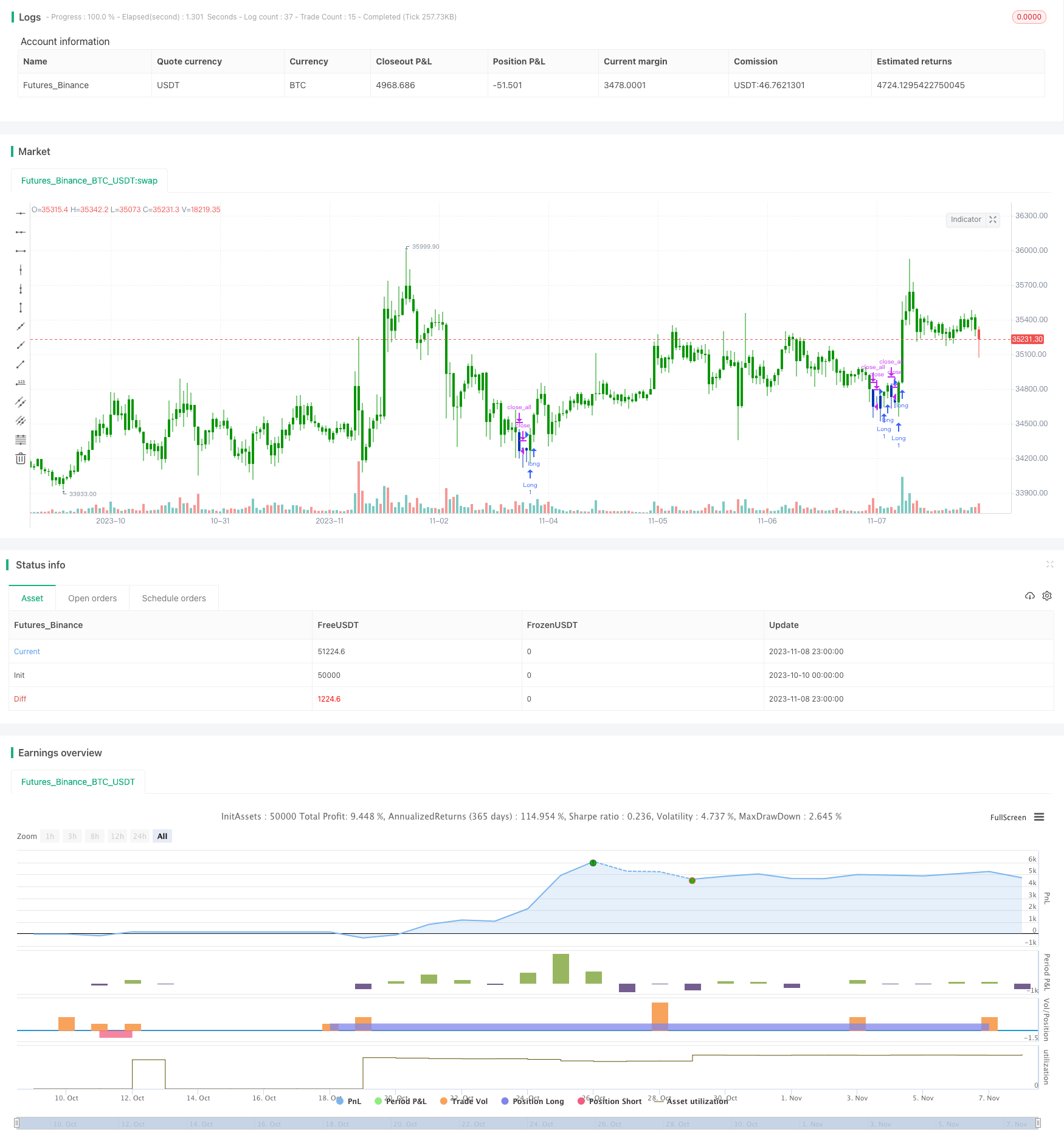
概述
聚变策略是一个结合123形态反转策略与高低位突破策略的量化交易策略。该策略通过不同时间周期上指标信号的综合判断,实现多时间周期资金优势组合,在中长线获取超额收益的目标。
策略原理
聚变策略由两部分组成:
123反转策略
该策略来自于Ulf Jensen的《我如何在期货市场上获得三倍收益》一书中P183的思想。它通过判断价格连续2日收盘价与前一日收盘价的关系,结合Stochastic指标判断市场的超买超卖情况,产生买入和卖出信号。具体来说,当连续2日收盘价较前一日收盘价上涨,且Stochastic Slow指标低于50时产生买入信号;当连续2日收盘价较前一日收盘价下跌,且Stochastic Fast指标高于50时产生卖出信号。该策略借助Stochastic指标判断市场超买超卖状况,避免在市场高位买入和低位卖出。高低位突破策略
该策略通过判断价格是否突破不同周期的高低位来确定交易信号。它计算当前周期及过去周期的最高价和最低价,当价格突破最高价时产生买入信号,突破最低价时产生卖出信号。该策略的优势在于能够识别出不同周期线形态特征,在趋势形成时较早进入市场。
聚变策略将上述两种策略进行组合,当两种策略的信号方向一致时,产生实际的交易信号。这样可以过滤掉一些因单一策略判断错误产生的无效信号,提高信号的可靠性。
策略优势
多时间周期综合判断,提高信号准确性
该策略融合了日线和更高时间周期的形态特征,能够提高交易信号判断的准确性,避免被市场短期波动误导。充分利用Stochastic指标的超买超卖判断
StochasticSlow指标的应用避免了在超买区急于买入,StochasticFast指标的应用避免了在超卖区急于卖出,减少不必要的亏损。及时捕捉趋势特征,降低错过机会的概率
高低位突破策略能够识别更长线周期内价格突破关键区域,较早进入趋势,降低错过机会的概率。多策略组合,可以灵活优化
策略由多个子策略组成,优化空间大,可以通过调整子策略参数或引入新的子策略进行优化,使策略更稳定可靠。策略逻辑清晰易理解
策略结构简单清晰,容易理解和修改,也便于后期维护。
策略风险
多时间周期综合增加信号滞后
虽然多时间周期综合判断可以提高信号准确性,但是也会一定程度增加信号的滞后,可能错过短线交易机会。123形态无法识别更长线趋势反转
123反转策略仅根据近几日行情判断,无法识别更长时间周期内的关键趋势反转点。周期参数设置不当可能导致虚假信号
Stochastic指标和高低位突破 周期参数设置不当都可能导致产生过多虚假交易信号。仅基于技术指标,对特殊行情的适应性较差
该策略仅基于技术指标,不考虑基本面信息,在重大黑天鹅事件发生时适应性较差。
对应风险的解决方法:
适当缩短计算周期,降低信号滞后。
尝试引入更长周期指标或形态作为滤波器。
优化参数设置,在回测中测试参数稳健性。
考虑结合基本面因素过滤信号。
策略优化方向
测试并优化各个子策略的参数,使之更稳健。
增加其他辅助决策逻辑,如基本面、资金流向等指标进行组合。
引入止损策略,以控制单笔交易最大损失。
针对特定品种进行参数细化,提高策略对该品种的适配性。
增加机器学习模型辅助决策。
总结
综上所述,聚变策略整合多时间尺度的技术指标优势,旨在提高信号判断的准确性和时间liness。相比单一技术指标策略,它具有更敏锐的趋势判断能力和更稳健的信号产生。但该策略也存在一定的滞后性,以及对特殊行情的适应性较弱等问题。未来可通过引入更多辅助工具,优化参数设定,提升策略的稳定性和收益率。
/*backtest
start: 2023-10-10 00:00:00
end: 2023-11-09 00:00:00
period: 1h
basePeriod: 15m
exchanges: [{"eid":"Futures_Binance","currency":"BTC_USDT"}]
*/
//@version=4
////////////////////////////////////////////////////////////
// Copyright by HPotter v1.0 25/11/2020
// This is combo strategies for get a cumulative signal.
//
// First strategy
// This System was created from the Book "How I Tripled My Money In The
// Futures Market" by Ulf Jensen, Page 183. This is reverse type of strategies.
// The strategy buys at market, if close price is higher than the previous close
// during 2 days and the meaning of 9-days Stochastic Slow Oscillator is lower than 50.
// The strategy sells at market, if close price is lower than the previous close price
// during 2 days and the meaning of 9-days Stochastic Fast Oscillator is higher than 50.
//
// Second strategy
// This script shows a high and low period value.
// Width - width of lines
// SelectPeriod - Day or Week or Month and etc.
// LookBack - Shift levels 0 - current period, 1 - previous and etc.
//
// WARNING:
// - For purpose educate only
// - This script to change bars colors.
////////////////////////////////////////////////////////////
Reversal123(Length, KSmoothing, DLength, Level) =>
vFast = sma(stoch(close, high, low, Length), KSmoothing)
vSlow = sma(vFast, DLength)
pos = 0.0
pos := iff(close[2] < close[1] and close > close[1] and vFast < vSlow and vFast > Level, 1,
iff(close[2] > close[1] and close < close[1] and vFast > vSlow and vFast < Level, -1, nz(pos[1], 0)))
pos
HLL(LookBack, SelectPeriod) =>
pos = 0.0
xHigh = security(syminfo.tickerid, SelectPeriod, high[LookBack])
xLow = security(syminfo.tickerid, SelectPeriod, low[LookBack])
vS1 = xHigh
vR1 = xLow
pos := iff(close > vR1, 1,
iff(close < vS1, -1, nz(pos[1], 0)))
pos
strategy(title="Combo Backtest 123 Reversal & High and Low Levels", shorttitle="Combo", overlay = true)
Length = input(14, minval=1)
KSmoothing = input(1, minval=1)
DLength = input(3, minval=1)
Level = input(50, minval=1)
//-------------------------
SelectPeriod = input(title="Resolution", type=input.resolution, defval="D")
LookBack = input(1, minval=0)
reverse = input(false, title="Trade reverse")
posReversal123 = Reversal123(Length, KSmoothing, DLength, Level)
posHLL = HLL(LookBack, SelectPeriod)
pos = iff(posReversal123 == 1 and posHLL == 1 , 1,
iff(posReversal123 == -1 and posHLL == -1, -1, 0))
possig = iff(reverse and pos == 1, -1,
iff(reverse and pos == -1 , 1, pos))
if (possig == 1)
strategy.entry("Long", strategy.long)
if (possig == -1)
strategy.entry("Short", strategy.short)
if (possig == 0)
strategy.close_all()
barcolor(possig == -1 ? #b50404: possig == 1 ? #079605 : #0536b3 )